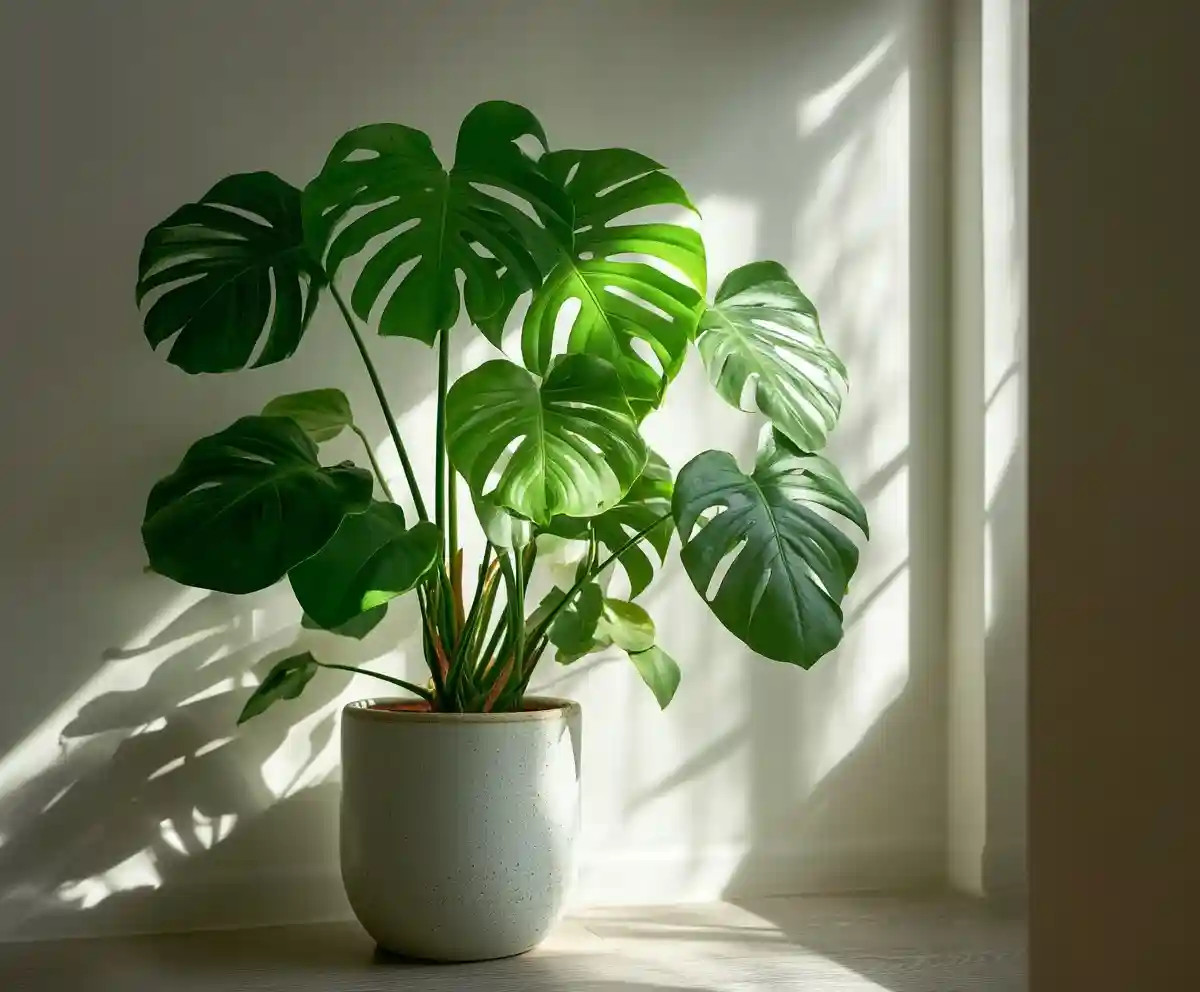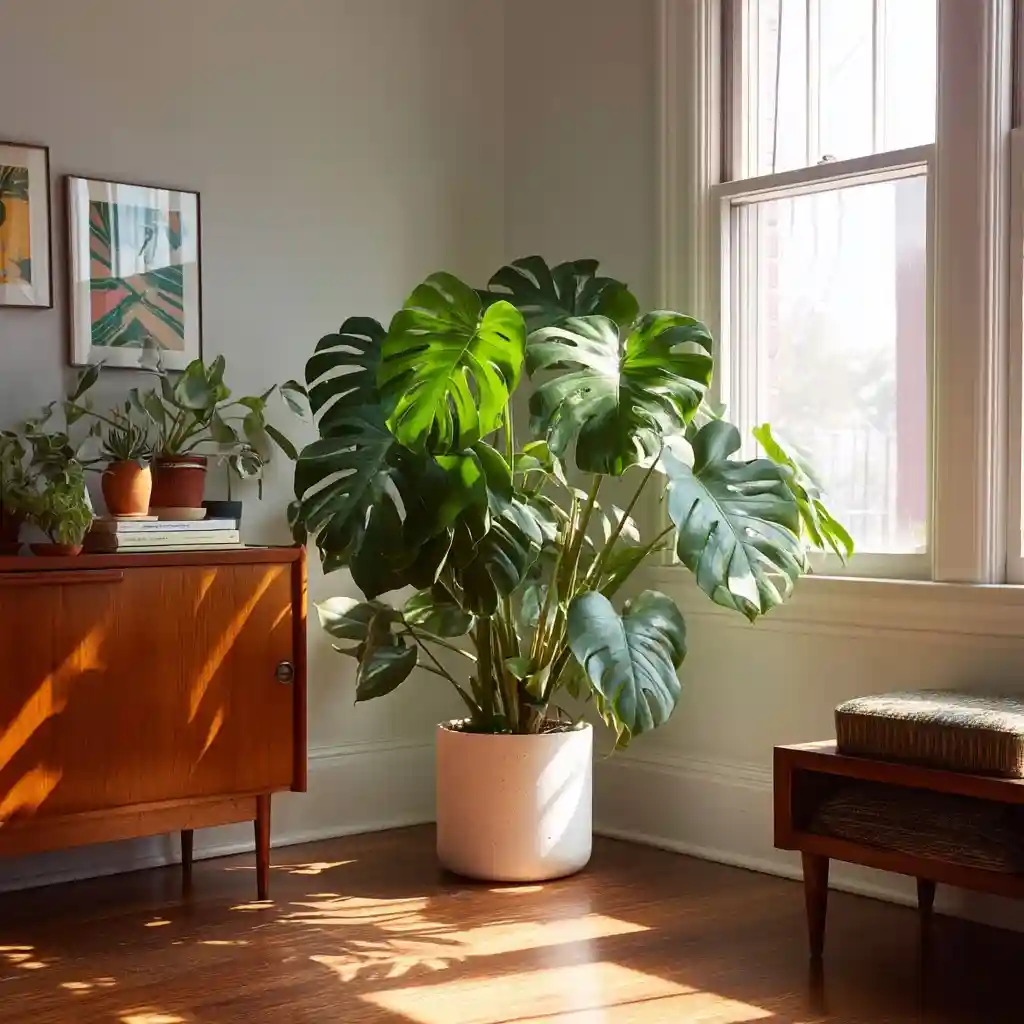Monstera is more than just a trendy houseplant—it’s a statement piece that brings a touch of the tropics to any indoor space. With its signature split leaves and climbing growth habit, Monstera has quickly become a favorite among plant lovers, especially those who appreciate bold greenery with minimal fuss. Whether you’re just getting started with houseplants or you’re ready to take your indoor jungle to the next level, learning the essentials of Monstera care indoors will help you grow a thriving, lush plant for years to come.
Native to the rainforests of Central America, Monstera deliciosa thrives in warm, humid conditions. But don’t worry—you don’t need a jungle to keep it happy. With a little attention to light, water, and soil, even beginner plant parents can enjoy this striking plant’s beauty. This guide covers everything you need to know to grow, maintain, and troubleshoot your Monstera indoors, with expert tips for propagation, repotting, pruning, and more.
Table of Contents
🌱 Monstera Care
When it comes to Monstera care indoors, understanding its basic needs will help you avoid common mistakes and keep your plant thriving. Here’s how to get it right from the start:
☀️ Light Requirements
Monstera plants love bright, indirect light. A spot a few feet away from an east- or south-facing window is usually perfect. While they can tolerate some shade, too little light can result in leggy growth and fewer leaf splits.
Avoid placing your Monstera in direct sunlight for extended periods—it can scorch the leaves. If natural light is limited, a full-spectrum grow light can keep your plant happy and promote lush growth.
🌱 Best Soil for Monstera
The ideal soil mix for Monstera care indoors should be well-draining, airy, and slightly acidic to neutral in pH. A peat-based potting mix enriched with perlite and orchid bark works well.
You can create your own mix using:
- 3 parts indoor plant soil
- 2 parts orchid bark or coco coir
- 1 part perlite
This combo ensures strong root development and prevents water from pooling around the roots.
💧 How to Water a Monstera
Monstera prefers to dry out slightly between waterings. Stick your finger into the top 2 inches of soil—if it’s dry, it’s time to water.
- In summer: Water once a week.
- In winter: Cut back to every 2–3 weeks.
Water deeply until it runs out of the drainage holes. Avoid letting the plant sit in water, as this can lead to root rot. Droopy or curling leaves are usually a sign it’s either too dry or too wet, so pay attention to the signals.
🌡️ Temperature and Humidity
As a tropical plant, Monstera thrives in temperatures between 65°F and 85°F. It can tolerate a dip to 50°F, but growth will slow. Avoid placing it near drafts, heaters, or air conditioners.
Humidity is also crucial—60% or higher is ideal. Use a humidifier, pebble tray, or group plants together to raise moisture levels naturally. Regular misting helps too, but make sure the leaves can dry out between sprays.
🌿 Fertilizing Monstera
During the active growing season (spring and summer), feed your Monstera every 4–6 weeks with a balanced liquid fertilizer (such as 3-1-2 or 1-1-1 ratio).
Dilute the fertilizer to half strength and apply after watering to avoid root burn. Skip feeding in winter when the plant’s growth slows down.
🍃 Encouraging Leaf Splits (Fenestration)
Want those dramatic split leaves? Light is the key. Young Monstera plants typically develop fenestrations as they mature, but this can be encouraged with strong, indirect light, regular watering, and consistent feeding.
A grow light can help if your plant isn’t getting enough natural light, especially during winter months.
🌿 Types of Monstera
While Monstera deliciosa is the most well-known, the Monstera genus includes nearly 50 species, each with its own unique look. Some are compact and perfect for small spaces, while others produce massive, fenestrated leaves that steal the show. Here’s a look at some popular types you might encounter:
🪴 Common Varieties
- Monstera deliciosa
The classic large-leaf variety with deep splits and holes. It’s fast-growing, dramatic, and ideal for indoor spaces with room to climb. - Monstera adansonii
Known as the Swiss cheese vine, this smaller species has elongated leaves filled with holes. Great for hanging baskets or trellises. - Monstera albo (Monstera deliciosa ‘Albo Borsigiana’)
A rare variegated version of M. deliciosa, featuring stunning white or cream patches. Slower-growing and more delicate. - Monstera obliqua
Often mistaken for adansonii, this ultra-rare plant has more holes than leaf. It’s extremely delicate and difficult to grow indoors. - Monstera dubia
Also called the shingle plant, it has flat, heart-shaped leaves that lie against a surface as it climbs. - Monstera Peru (Monstera karstenianum)
Known for its thick, textured, dark green leaves. Unlike other Monsteras, it doesn’t produce fenestrations. - Monstera Thai Constellation
A cultivated variety of M. deliciosa with marbled, creamy-white variegation. Highly sought after and relatively slow-growing.
🛒 Tips for Buying
If you’re shopping for a Monstera in-store:
- Check for pests under the leaves and in the soil.
- Look for new growth — a sign of a healthy plant.
- Avoid root-bound plants, which may be stressed.
- Read care tags to make sure you’re getting a species that suits your space and lighting.
✂️ Pruning Your Monstera
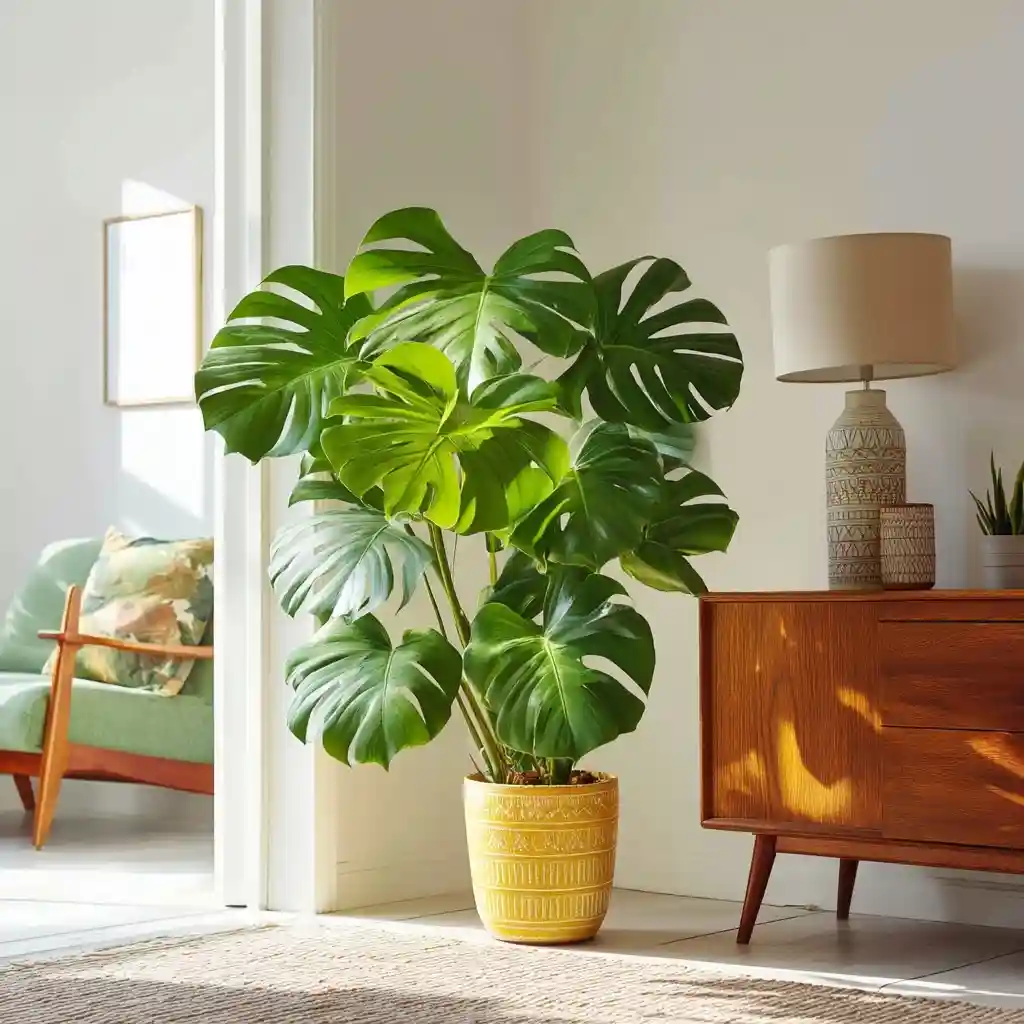
Pruning is an important part of Monstera care indoors, especially as the plant matures and starts to outgrow its space. Regular trimming helps control its size, removes damaged or yellowing leaves, and encourages new, healthier growth.
🪴 When and Why to Prune
- Timing: Prune during the active growing season (spring or early summer) to avoid shocking the plant.
- Purpose:
- Shape the plant and manage leggy growth
- Remove yellow, brown, or damaged leaves
- Encourage bushier, fuller growth
- Trim aerial roots if they become unruly (optional)
✂️ How to Prune a Monstera
- Use clean, sharp tools
Disinfect pruning shears with rubbing alcohol to prevent disease spread. - Identify what to cut
Focus on dead or damaged leaves first. Then trim long vines or leaves that are crowding others. - Make cuts just above a node
A node is the small bump on the stem where a leaf or root will grow. Cutting just above it promotes new branching. - Don’t overdo it
Never remove more than 25–30% of the plant at one time. Too much pruning can stress your Monstera.
🌱 What About Aerial Roots?
Aerial roots are the long, stringy roots that grow from the stem. These help the Monstera climb and find moisture in nature. Indoors, they’re optional. You can:
- Leave them be
- Train them to climb a moss pole
- Trim them if they get in the way (they won’t harm the plant)
If you do cut them, be sure to avoid cutting into the main stem, as this can damage the plant.
🌱 Propagating Monstera
Propagating your Monstera is a simple and rewarding way to multiply your plant collection—or share it with a friend. Whether you’re trimming back a leggy vine or just want a new plant, you can propagate using stem cuttings or air layering.
Both methods are easy to do at home and result in healthy, rooted plants with proper care.
✂️ Propagating Monstera with Stem Cuttings
This is the most popular and beginner-friendly method.
What You’ll Need:
- Clean pruning shears
- A glass jar or vase
- Filtered or rainwater
- A warm, bright space
Step-by-Step:
- Locate a node
Find a section of stem with a node (a bump where roots will grow), preferably with 1–2 leaves and an aerial root if possible. - Cut below the node
Make a clean cut just beneath the node with sterilized shears. - Place in water
Submerge the node in water, leaving the leaves above the surface. - Change water every 3–5 days
Use filtered water and keep the cutting in bright, indirect light. - Wait for roots to grow
In a few weeks to a couple of months, roots will form. Once they’re at least 2 inches long, transplant into soil.
🌿 Air Layering Method
Air layering is a bit more involved but less stressful for the mother plant and often results in faster rooting.
What You’ll Need:
- Sphagnum moss (soaked)
- Plastic wrap or a clear bag
- Twist ties or string
- Clean shears
Step-by-Step:
- Choose your stem
Find a stem with an aerial root or visible node. - Make a shallow notch
Cut a small slit (about 1/3 into the stem) just below the node. - Wrap with moss
Cover the wounded area and node with moist sphagnum moss. - Seal with plastic
Wrap the moss in plastic wrap and secure with twist ties. Poke small holes for airflow if needed. - Keep moss moist
Mist it every few days to maintain moisture. - Wait for roots
After several weeks, roots will develop in the moss. At that point, cut below the rooted section and plant it in soil.
Both methods are excellent for growing new Monstera plants—and also help keep your original plant manageable in size.
🪴 Potting & Repotting Monstera
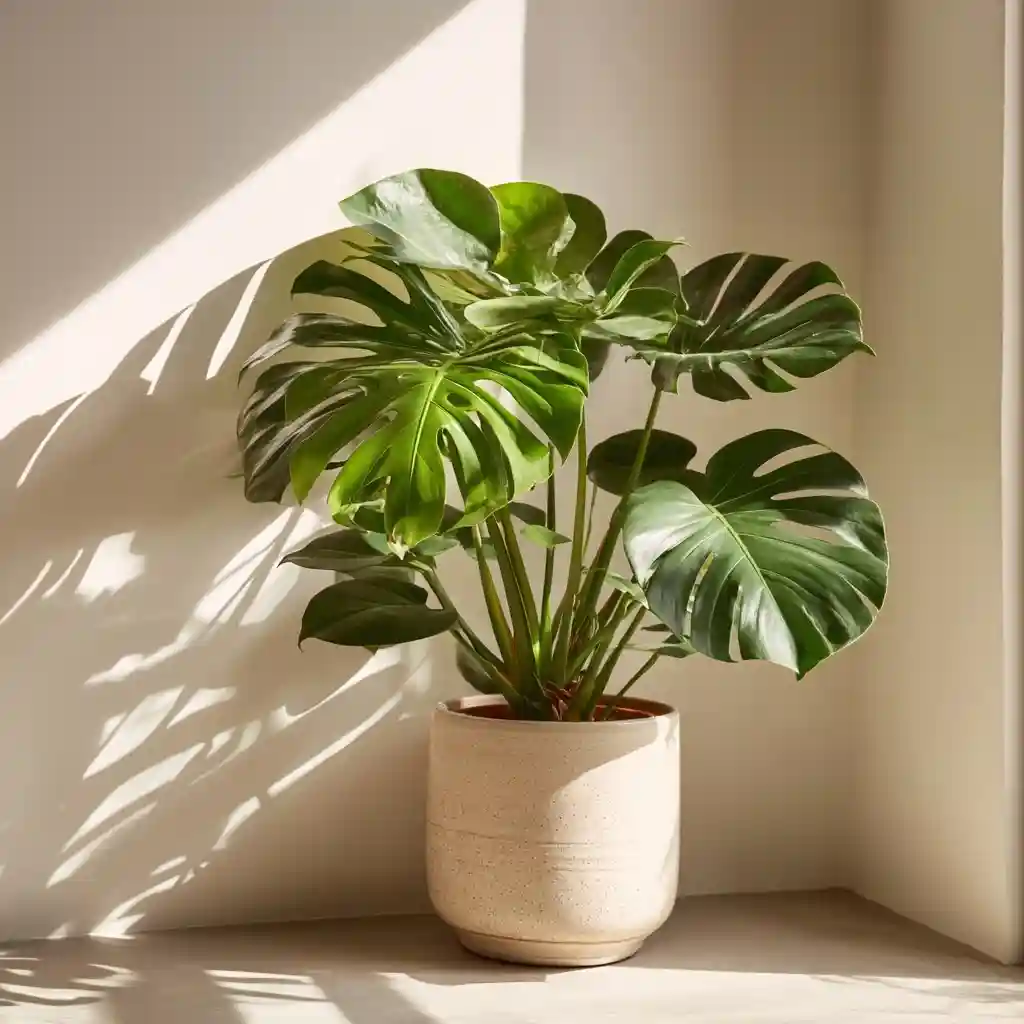
Monstera plants are fast growers. If yours is suddenly drooping, yellowing, or roots are spilling out the bottom, it might be time for a new home. Proper potting not only gives your plant room to thrive, but also prevents problems like root rot and stunted growth.
🪻 When to Repot
You should repot your Monstera every 1–2 years, or when you notice any of the following:
- Roots are growing through drainage holes
- Water runs straight through the pot
- Soil dries out unusually fast
- Growth has slowed or stopped
- The plant is top-heavy and leaning
🏺 Choosing the Right Pot
The ideal pot for Monstera care indoors should:
- Be 2–3 inches larger in diameter than the current one
- Have drainage holes to prevent soggy soil
- Be made of breathable materials like terracotta or ceramic (optional, but preferred)
💡 Pro Tip: A general rule is to match the pot size to the diameter of the largest leaf. For example, if your biggest Monstera leaf is 10 inches wide, use a 10-inch pot.
🌱 How to Repot a Monstera
- Prepare the new pot
Fill the bottom third with a fresh, airy potting mix (peat-based, with perlite and bark). - Loosen the roots
Gently remove the plant from its old pot and shake off loose soil. Untangle any bound roots. - Position and stake
Place the Monstera in the center. If using a moss pole or support, insert it now and secure the stem. - Backfill with soil
Add soil around the roots, pressing gently to remove air pockets. Avoid burying the stem too deeply. - Water thoroughly
Give your plant a good soak and let excess water drain out completely. - Watch the light
Keep your Monstera in a spot with bright, indirect light while it adjusts to its new home.
🐛 Common Pests
Pests are a nuisance, but thankfully, Monstera isn’t highly susceptible to infestations—especially if you maintain good hygiene and airflow. Still, some sap-sucking insects can appear, particularly if the plant is stressed or sits in poor conditions.
Here are the most common offenders:
🕷️ Spider Mites
- Signs: Fine webbing between leaves, yellow speckling, leaf drop
- Treatment: Wipe leaves with a soft cloth and spray with neem oil or insecticidal soap. Increase humidity—mites hate moisture.
🐞 Mealybugs
- Signs: White, cottony clumps at nodes or under leaves
- Treatment: Dab with isopropyl alcohol using a cotton swab. Remove affected areas and repeat weekly until clear.
🦟 Fungus Gnats
- Signs: Tiny black flies hovering around the soil
- Treatment: Let the top layer of soil dry out. Use yellow sticky traps, and consider a layer of sand or cinnamon on the surface to deter egg-laying.
🐜 Thrips
- Signs: Silvery streaks on leaves, black specks (frass), leaf curling
- Treatment: Rinse leaves thoroughly. Follow up with neem oil or an insecticidal soap every few days.
🐚 Scale Insects
- Signs: Hard, brownish bumps on stems or the underside of leaves
- Treatment: Scrape off gently with a soft toothbrush or cloth. Treat with horticultural oil or neem.
🧽 Preventative Care Tips
- Dust your leaves weekly with a damp cloth to keep pests from settling.
- Quarantine new plants for at least two weeks before placing them near your existing houseplants.
- Inspect under leaves and stems regularly for early signs of trouble.
🦠 Common Pests and Diseases
While pests are annoying, fungal and bacterial diseases can be more destructive if not caught early. Fortunately, most of these issues can be managed with consistent care and preventive habits.
🌫️ Powdery Mildew
- Cause: High humidity with low airflow
- Symptoms: White, powdery coating on leaves
- Solution: Trim affected leaves. Improve air circulation. Use neem oil or a fungicide safe for houseplants.
🟤 Root Rot
- Cause: Overwatering or poor drainage
- Symptoms: Yellowing leaves, mushy roots, wilting despite moist soil
- Solution: Remove plant from pot, cut off mushy roots, and repot in fresh, well-draining soil. Let it dry slightly between waterings moving forward.
💡 Tip: Always use pots with drainage holes to prevent water buildup.
🟡 Leaf Spot
- Cause: Fungal or bacterial infection, often from splashing water
- Symptoms: Yellow, brown, or black circular spots on leaves
- Solution: Prune affected leaves. Water at the base, not from above. Consider a copper-based fungicide if spreading continues.
🪰 Fungus Gnats (Revisited)
Though mentioned earlier under pests, these flies also point to moist, fungus-prone soil—which can increase disease risk. Keep the soil surface dry and treat with BTI (Bacillus thuringiensis israelensis) if needed.
🧴 How to Prevent Disease
- Avoid overwatering
- Improve airflow by spacing plants
- Wipe dust off leaves weekly
- Sterilize tools after pruning
- Avoid letting leaves sit wet overnight
Keeping your Monstera clean and well-spaced goes a long way in preventing most of these issues.
🚨 Common Monstera Problems
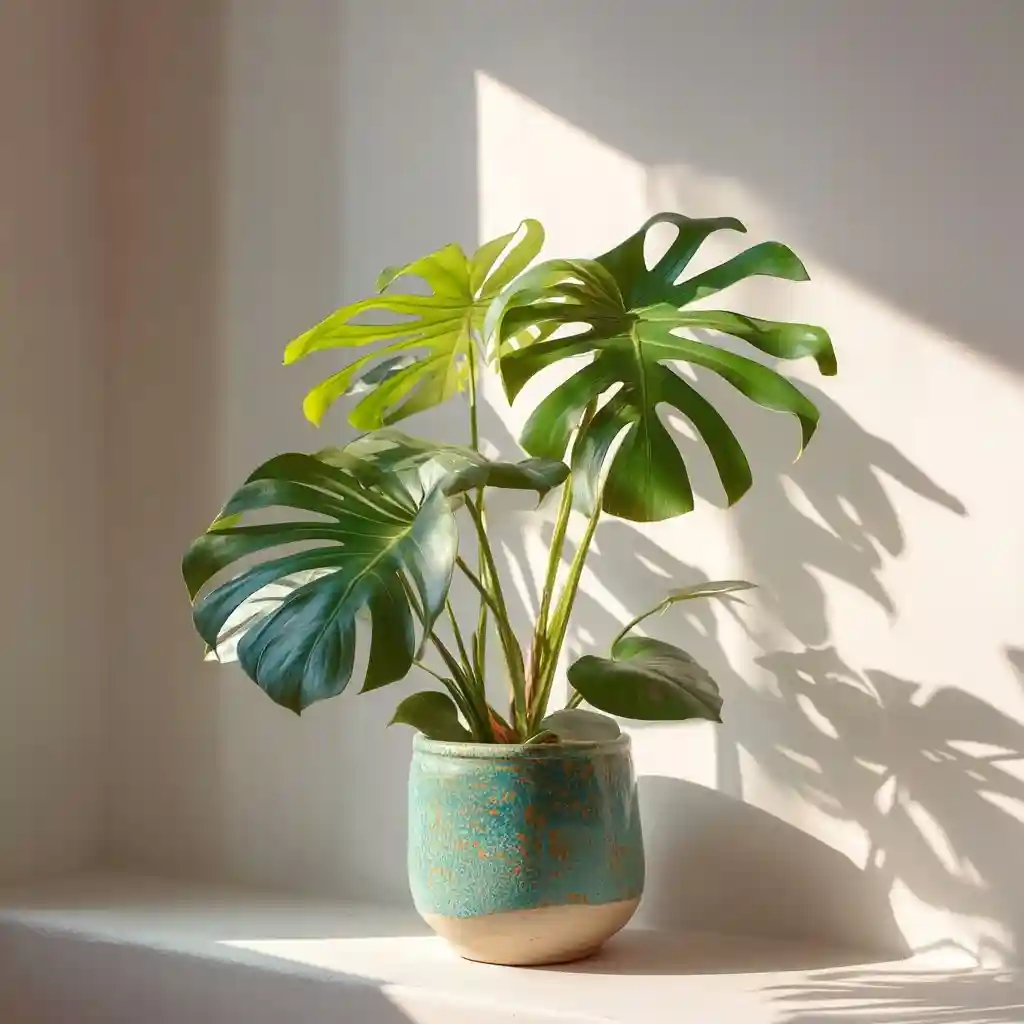
Not every yellow leaf means disaster. Many common Monstera issues are reversible once you identify the cause. Here’s how to recognize and fix the most frequent symptoms.
🍂 Browning Leaf Tips
Cause: Low humidity or inconsistent watering
Fix:
- Use a humidifier or mist regularly
- Stick to a watering schedule
- Trim brown edges with sterile scissors to improve appearance
If the browning includes a yellow halo, it may be fungal. In that case, remove affected leaves and reduce humidity slightly.
💛 Yellowing Leaves
Cause: Overwatering or compacted soil
Fix:
- Let soil dry out more between waterings
- Repot if drainage is poor
- Only remove yellow leaves once they’re fully dead
Yellowing often starts with the oldest leaves near the base—this is natural. But rapid or widespread yellowing signals a problem.
🌿 Drooping, Curling, or Wilting
Cause: Either too much or too little water, or low humidity
Fix:
- Check the top few inches of soil
- Dry? → Water deeply
- Wet? → Allow to dry and check for root rot
- Increase humidity if leaves are curling
- Move away from vents, heaters, or drafts
⚫ Black Spots on Leaves
Cause: Fungal or bacterial disease
Fix:
- Remove infected leaves with clean tools
- Disinfect scissors after each cut
- Improve air circulation and avoid misting in cooler, stagnant conditions
- Treat remaining leaves with neem oil or a houseplant-safe fungicide
If spots are wet or slimy, you’re likely dealing with bacteria rather than fungus. Quarantine the plant if needed.
🛠 Quick Troubleshooting Checklist
| Symptom | Likely Cause | Fix |
|---|---|---|
| Yellow leaves | Overwatering | Dry out soil, reduce watering frequency |
| Brown leaf tips | Low humidity or fungus | Increase humidity, trim, remove fungus |
| Curling leaves | Dry soil, low humidity | Water, humidify, relocate from dry air |
| Drooping leaves | Root rot or dehydration | Adjust watering, check soil moisture |
| Black spots | Bacterial/fungal infection | Prune, improve airflow, apply neem oil |
❓ Monstera FAQs
🌤️ Can Monstera grow in low light?
Monstera prefers bright, indirect light. While it can survive in low-light conditions, it may grow slowly and produce smaller, non-fenestrated leaves. For best results, place it near an east- or south-facing window with filtered light.
🌱 Why isn’t my Monstera’s leaf splitting?
Leaves typically start to split (fenestrate) as the plant matures, which can take 2–3 years. Ensure your Monstera gets enough light, water, and nutrients. A grow light can help if you’re relying on artificial lighting indoors.
🐾 Is Monstera toxic to pets?
Yes. Monstera contains calcium oxalate crystals, which are toxic if ingested by pets or children. It’s not toxic to touch, but be cautious of the sap and keep the plant out of reach.
💧 How often should I water my Monstera?
Water your Monstera when the top 2 inches of soil feel dry. In warm seasons, that’s usually once a week. In cooler months, water every 2–3 weeks depending on humidity and light levels.
💸 Why are some Monstera plants so expensive?
Rare varieties like Monstera Albo or Thai Constellation are harder to propagate and grow more slowly. This, along with high demand, drives up their price. Mature plants with established fenestration also fetch higher prices.
🪴 What’s the difference between Monstera deliciosa and adansonii?
Both are called Swiss cheese plants, but Monstera deliciosa has larger, lobed leaves with splits and holes, while adansonii has smaller, oval leaves with more perforations and a vine-like growth habit.
🌿 Conclusion
Caring for a Monstera plant indoors doesn’t have to be complicated. With the right balance of light, water, humidity, and space to grow, your Monstera can become the crown jewel of your indoor garden. From pruning and propagation to troubleshooting common issues, understanding your plant’s needs is the key to keeping it healthy and beautiful year-round.
Whether you’re growing a classic Monstera deliciosa or trying your hand with a rare variegated variety, following the care tips outlined above will set you up for success. Keep observing your plant, make adjustments as needed, and enjoy the rewarding process of watching it thrive.

